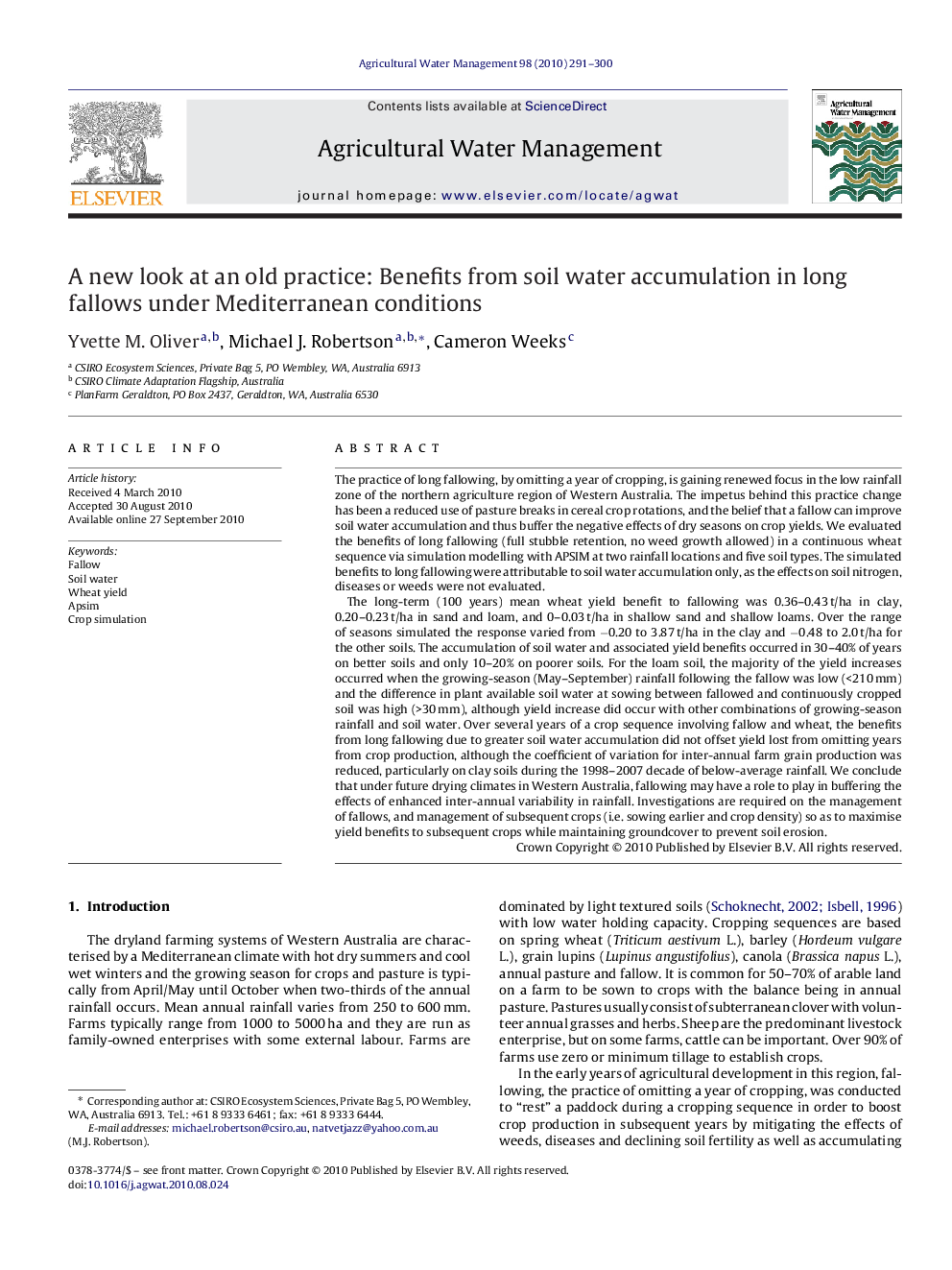| Article ID | Journal | Published Year | Pages | File Type |
|---|---|---|---|---|
| 4479521 | Agricultural Water Management | 2010 | 10 Pages |
The practice of long fallowing, by omitting a year of cropping, is gaining renewed focus in the low rainfall zone of the northern agriculture region of Western Australia. The impetus behind this practice change has been a reduced use of pasture breaks in cereal crop rotations, and the belief that a fallow can improve soil water accumulation and thus buffer the negative effects of dry seasons on crop yields. We evaluated the benefits of long fallowing (full stubble retention, no weed growth allowed) in a continuous wheat sequence via simulation modelling with APSIM at two rainfall locations and five soil types. The simulated benefits to long fallowing were attributable to soil water accumulation only, as the effects on soil nitrogen, diseases or weeds were not evaluated.The long-term (100 years) mean wheat yield benefit to fallowing was 0.36–0.43 t/ha in clay, 0.20–0.23 t/ha in sand and loam, and 0–0.03 t/ha in shallow sand and shallow loams. Over the range of seasons simulated the response varied from −0.20 to 3.87 t/ha in the clay and −0.48 to 2.0 t/ha for the other soils. The accumulation of soil water and associated yield benefits occurred in 30–40% of years on better soils and only 10–20% on poorer soils. For the loam soil, the majority of the yield increases occurred when the growing-season (May–September) rainfall following the fallow was low (<210 mm) and the difference in plant available soil water at sowing between fallowed and continuously cropped soil was high (>30 mm), although yield increase did occur with other combinations of growing-season rainfall and soil water. Over several years of a crop sequence involving fallow and wheat, the benefits from long fallowing due to greater soil water accumulation did not offset yield lost from omitting years from crop production, although the coefficient of variation for inter-annual farm grain production was reduced, particularly on clay soils during the 1998–2007 decade of below-average rainfall. We conclude that under future drying climates in Western Australia, fallowing may have a role to play in buffering the effects of enhanced inter-annual variability in rainfall. Investigations are required on the management of fallows, and management of subsequent crops (i.e. sowing earlier and crop density) so as to maximise yield benefits to subsequent crops while maintaining groundcover to prevent soil erosion.
Research highlights▶ The practice of long fallowing, by omitting a year of cropping, is gaining renewed focus in the low rainfall zone of the northern agriculture region of Western Australia. ▶ Simulated crop yield responses to fallowing vary with soil type and rainfall location. ▶ The accumulation of soil water and associated yield benefits occurred in 30–40% of years on better soils and only 10–20% on poorer soils. ▶ For the loam soil, the majority of the yield increases occurred when the growing-season rainfall following the fallow was low and the difference in plant available soil water at sowing between fallowed and continuously cropped soil was high. ▶ Over several years of a crop sequence involving fallow and wheat, the benefits from long fallowing due to greater soil water accumulation did not offset yield lost from omitting years from crop production, although the coefficient of variation for inter-annual farm grain production was reduced. ▶ Fallowing may have a role to play in buffering the effects of enhanced inter-annual variability in rainfall.
